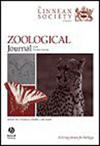请真正的入侵蜗牛站起来好吗?对servilis (Shuttleworth, 1852)的系统发育的重新考虑(腹足目:柱头虫目:点状虫科)
IF 2.8
2区 生物学
Q1 ZOOLOGY
引用次数: 0
摘要
本文通过对全球入侵最严重的外来陆生蜗牛的综合实证修正,重新审视了其生物多样性和生物地理学特征。从nDNA (ELAV, ddRAD基因组学)和mtDNA (COI)获得的系统发育学结果表明,目前的分类是错误的,在servilis s.l中至少有5个不同的物种。因此,这里对servilis类群的解释包括:servilis,推断原产于环太平洋西南部,外来性分布最小,横跨北美、欧洲和东大西洋的Macaronesian群岛;P. amblygona (Reinhardt, 1877),原产于日本本州;P. borealis (Pilsbry and Y. Hirase, 1905),原产于日本北海道,沿环太平洋至北美西南部山脉;P. caputspinulae (Reeve, 1852),原产于新西兰和Lord Howe岛;和P. morti (J.C. Cox, 1864),原产于澳大利亚东南部。在servilis中,入侵似乎仅限于可能在加利福尼亚海岸出现的单一分支。本文提出的工作提醒我们,当本地物种被视为外来物种时,未经经验审查的分类学概念可能会产生较差的生物多样性观点和非最佳保护策略。本文章由计算机程序翻译,如有差异,请以英文原文为准。
Will the real invasive snail please stand up? A phylogenetic reconsideration of Paralaoma servilis (Shuttleworth, 1852) (Gastropoda: Stylommatophora: Punctidae)
We reconsider the biodiversity and biogeography of Paralaoma servilis—believed to be one of the most globally invasive exotic land snails—through integrative empirical revision. Phylogenies obtained from nDNA (ELAV, ddRAD genomics) and mtDNA (COI) demonstrate that the current classification is in error, with there being at least five distinct species within P. servilis s.l. The P. servilis group as interpreted here thus includes: P. servilis, inferred to be native to south-western Pacific Rim with an adventive distribution minimally spanning North America, Europe, and the Macaronesian islands of the eastern Atlantic Ocean; P. amblygona (Reinhardt, 1877), native to Honshu, Japan; P. borealis (Pilsbry and Y. Hirase, 1905), native to Hokkaido, Japan along the Pacific Rim to the SW North American mountains; P. caputspinulae (Reeve, 1852), native to New Zealand and Lord Howe Island; and P. morti (J.C. Cox, 1864), native to south-eastern Australia. Within P. servilis, invasiveness appears limited to a single clade that may have arisen along the California coast. The work presented here is a reminder that taxonomic concepts that have not been subjected to empirical vetting can generate poor biodiversity perspectives and non-optimal conservation strategies when native species are treated as exotics.
求助全文
通过发布文献求助,成功后即可免费获取论文全文。
去求助
来源期刊
CiteScore
6.50
自引率
10.70%
发文量
116
审稿时长
6-12 weeks
期刊介绍:
The Zoological Journal of the Linnean Society publishes papers on systematic and evolutionary zoology and comparative, functional and other studies where relevant to these areas. Studies of extinct as well as living animals are included. Reviews are also published; these may be invited by the Editorial Board, but uninvited reviews may also be considered. The Zoological Journal also has a wide circulation amongst zoologists and although narrowly specialized papers are not excluded, potential authors should bear that readership in mind.

 求助内容:
求助内容: 应助结果提醒方式:
应助结果提醒方式:


